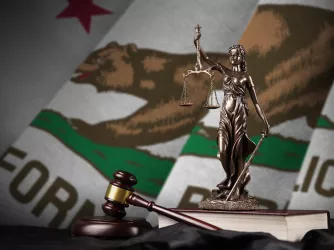Table of Contents
Education Department to Senate Committee: ‘Preponderance’ Mandate Is Not Law

Despite repeated enforcement actions, the Department of Education once again insisted in testimony before a Senate committee last week that department “guidance” on the standard of proof for adjudicating campus Title IX violations is not binding law.
Last week, the Senate Homeland Security and Governmental Affairs Committee’s Subcommittee on Regulatory Affairs and Federal Management held a third hearing on agency regulatory guidance to explore overreach by federal agencies. (The committee’s website has videos of this and the other two hearings.)
During this latest hearing, Department of Education Assistant Secretary Amy McIntosh once again testified that the April 4, 2011 “Dear Colleague” letter (DCL) is non-binding and does not have the force of law. (She and several other Department of Education officials have repeatedly told Congress that the DCL was non-binding despite enforcing it as if it were binding.)
The exchange—which starts at the 1:16:00 mark of the hearing video—began when Senator James Lankford, who chairs the subcommittee, asked McIntosh how the agency would respond to an institution of higher education that opted to stick with the “clear and convincing” standard of evidence in contradiction to the DCL’s “preponderance of the evidence” mandate:
Senator Lankford: Last year Secretary King and I were having a conversation in one of the hearings and we were talking about the 2011 Dear Colleague sexual assault guidance that was put out—the change from clear and convincing evidence, which most universities used, to the preponderance of evidence, and to try to figure out how this works within that institution. Ms. Smith was alluding to something that we’ve all talked about: It’s not legally binding. The question is, if a school chooses to apply clear and convincing evidence in their issues for sexual assault, how would the department respond?
Ms. McIntosh: Thank you for including me in this conversation and for that question. I am not a lawyer and you did ask me before about the change, what you determined, what you call a change in the standard of evidence. It is my understanding that our Dear Colleague that makes a reference to the preponderance did not change our interpretation—longstanding interpretation—
Senator Lankford: I could introduce you to a lot of university presidents that don’t agree with that statement and a tremendous number of law professors across the country that don’t agree with that statement. They see it as a very large change in how evidence is handled.
Ms. McIntosh: So, we may have to disagree for this moment, but that was the evidence standard that our agency had been using, and it’s what we understand many universities were using and we think it properly derives from the words in Title IX, so that said, that guidance document, again, does not have the force of law, so guidance document itself—
Senator Lankford: So, I’m so sorry to interrupt. Can you help me understand from Title IX, where that comes from? And again, I’m not trying to put you on the spot, but you were just mentioning you think it comes from Title IX and from the word that’s there. I can’t seem to draw that standard from anything that I read in Title IX.
Ms. McIntosh: So, I will tell you what I believe the source is. So, this is our interpretation of the words “equitable” in the Title IX regulation and this burden of proof is how we—here we go. It’s apparently multiple administrations, not just our administration, that for procedures to be equitable they must use the preponderance of evidence standard and that’s our interpretation of Title IX. Now the guidance document itself simply explains that. It does not have the force of law. So any—
Senator Lankford: So we are back to my original question. If a university were to choose to use clear and convincing standards versus preponderance of evidence, what does the Department of Education do with that school?
Ms. McIntosh: Well, so what would happen in all of our enforcement is there could potentially be a complaint that comes from someone who feels that the sexual harassment policy in the university was violating their rights and we would investigate that complaint thoroughly and around all the specific facts of that individual case. And that could take some time. And we would then come to a determination on the law—not about our guidance, but on the law—and work with the university to come into compliance if that was required.
Senator Lankford: I’m still waiting. I’m sorry. If a university uses clear and convincing as their evidence standard which many have for a long time—
Ms. McIntosh: I can’t answer about any hypothetical case or example where there might be clear and convincing—
[...]
Senator Lankford: So at this point, your statement would be that it doesn’t have the force of law. That is your understanding.
Ms. McIntosh: Our guidance document does not have the force of law. We would investigate complaints on a case by case basis and much of that goes well beyond the evidence standard, to all the circumstances and facts about how a university handles sexual harassment complaints and work with the university to come to a better place.
So there you have it. The Department of Education will not answer the Senator’s question in a straightforward manner. But it doesn’t have to, because the department’s actions speak for themselves.
Over and over again, the department is forcing institutions to adopt the preponderance of the evidence standard or risk an enforcement action to strip them of their federal funding, which really underscores the question: If the terms of guidance documents can be enforced as though they are binding, what is the difference between documents that have the force of law and guidance documents that do not? Like Senator Lankford, we are still waiting for an answer.
Recent Articles
FIRE’s award-winning Newsdesk covers the free speech news you need to stay informed.

One day after FIRE lawsuit, Congress passes changes to filming permits in national parks

VICTORY: FIRE lawsuit leads California to halt law penalizing reporters, advocates, and victims who discuss publicly known information about sealed arrest records

O holy fight: New Hampshire Satanic Temple statue threatened by more than vandals
